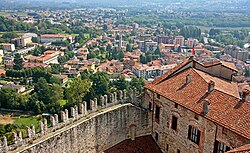Angera
Angera | |
|---|---|
| Città di Angera | |
 | |
UTC+2 (CEST) | |
| Postal code | 21021 |
| Dialing code | 0331 |
| Patron saint | Santa Maria Assunta |
| Saint day | 15 August |
| Official website | |
Angera (Italian:
History
The earliest known inhabitants of the area were hunter-gatherers who made use of the cave known as the Wolf's Den (Tana del Lupo), at the foot of the cliffs. By the Roman era, Angera (then known as Statio, a place for changing horses) was an important lakeside port on a trading route, but by the fourth century it was in decline, and in 411 was destroyed, along with
In 1776, the Italian physicist Alessandro Volta first discovered methane in the marshlands of Angera while on his summer holidays. He succeeded in isolating the gas, which he called inflammable air from marshlands, in 1778. It was what we nowadays call methane.[4]
Main buildings
One of the main buildings in the town is the
People
Peter Martyr d'Anghiera (1457–1526), the historian of Spain, was born in Angera,[6] as was Cristoforo Solari, called il Gobbo (c.1460–1527), sculptor and architect. Teresa Ciceri Castiglioni (1750–1821) the inventor and agronomist was born here. The Italian footballer Francesco Russo also comes from here.
Twin towns
 Viviers, France
Viviers, France
References
- ^ "Superficie di Comuni Province e Regioni italiane al 9 ottobre 2011". Italian National Institute of Statistics. Retrieved 16 March 2019.
- ^ "Popolazione Residente al 1° Gennaio 2018". Italian National Institute of Statistics. Retrieved 16 March 2019.
- ISBN 978-1-312-49438-1.
- ^ "Biography".
- ^ "Sanctuary of Madonna della Riva". Retrieved 2015-09-02.
- ^ The Penny Cyclopaedia of the Society for the Diffusion of Useful Knowledge. 1837. p. 417.
External links




